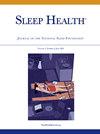Social epidemiology of bedtime screen use behaviors and sleep outcomes in early adolescence
IF 3.4
2区 医学
Q2 CLINICAL NEUROLOGY
引用次数: 0
Abstract
Objectives
The current study aimed to determine sociodemographic associations of bedtime screen use behaviors and the sociodemographic differences in the associations between bedtime screen use and sleep outcomes in a national (US) study of early adolescents.
Methods
We analyzed cross-sectional data from 10,305 early adolescents (12-13 years, 48.4% female) in the Adolescent Brain Cognitive Development (ABCD) Study (Year 3, 2019-2021). Multiple regression analyses examined associations between (1) sociodemographic factors (age, sex, race and ethnicity, sexual orientation, household income, parental education, and number of siblings) and adolescent-reported bedtime screen use and (2) bedtime screen use and sleep outcomes (caregiver-reported sleep disturbance and self-reported sleep duration).
Results
Older age, female sex, sexual minority status, lower household income, and lower parent education were associated with more bedtime screen use. Black, Native American, and Latino/Hispanic race/ethnicity were associated with more bedtime screen use compared with White race, regardless of household income or parent education. More bedtime screen use was linked to greater sleep disturbances, with stronger effects observed in male adolescents. More bedtime screen use was also associated with shorter sleep duration, particularly among female adolescents and individuals from households with higher income and parental education levels. Although sexual minority identification was associated with more bedtime screen use, it was not associated with worse sleep outcomes among these adolescents.
Conclusions
Given sociodemographic differences in bedtime screen use, digital literacy education and anticipatory guidance could focus on at-risk early adolescent populations. Findings can inform targeted counseling by pediatricians and family media plans for diverse populations.
青少年早期睡前屏幕使用行为和睡眠结果的社会流行病学。
目的:目前的研究旨在确定睡前屏幕使用行为的社会人口学关联,以及睡前屏幕使用与早期青少年睡眠结果之间关联的社会人口学差异。方法:我们分析了2019-2021年青少年大脑认知发展(ABCD)研究(第三年)中10,305名早期青少年(12-13岁,48.4%为女性)的横断面数据。多元回归分析检验了(1)社会人口学因素(年龄、性别、种族和民族、性取向、家庭收入、父母教育程度和兄弟姐妹数量)和青少年报告的睡前屏幕使用情况之间的关系;(2)睡前屏幕使用情况和睡眠结果(照顾者报告的睡眠障碍和自我报告的睡眠时间)之间的关系。结果:年龄较大、女性、性少数、家庭收入较低、父母受教育程度较低与睡前屏幕使用较多有关。与白人相比,黑人、美洲原住民和拉丁裔/西班牙裔种族/民族与更多的睡前屏幕使用有关,无论家庭收入或父母的教育程度如何。更多的睡前屏幕与更严重的睡眠障碍有关,在男性青少年中观察到更强的影响。睡前使用屏幕时间越长,睡眠时间越短,尤其是在女性青少年和来自高收入和父母教育水平家庭的个人中。虽然性少数认同与更多的睡前屏幕使用有关,但与这些青少年更差的睡眠结果无关。结论:考虑到睡前屏幕使用的社会人口差异,数字素养教育和预期指导可以关注高危早期青少年人群。研究结果可以为儿科医生提供有针对性的咨询和针对不同人群的家庭媒体计划提供信息。
本文章由计算机程序翻译,如有差异,请以英文原文为准。
求助全文
约1分钟内获得全文
求助全文
来源期刊

Sleep Health
CLINICAL NEUROLOGY-
CiteScore
6.30
自引率
9.80%
发文量
114
审稿时长
54 days
期刊介绍:
Sleep Health Journal of the National Sleep Foundation is a multidisciplinary journal that explores sleep''s role in population health and elucidates the social science perspective on sleep and health. Aligned with the National Sleep Foundation''s global authoritative, evidence-based voice for sleep health, the journal serves as the foremost publication for manuscripts that advance the sleep health of all members of society.The scope of the journal extends across diverse sleep-related fields, including anthropology, education, health services research, human development, international health, law, mental health, nursing, nutrition, psychology, public health, public policy, fatigue management, transportation, social work, and sociology. The journal welcomes original research articles, review articles, brief reports, special articles, letters to the editor, editorials, and commentaries.
 求助内容:
求助内容: 应助结果提醒方式:
应助结果提醒方式:


